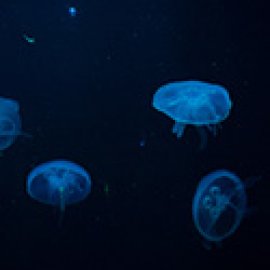Marine Biomimetics, part three
-
English
-
ListenPause
[intro music]
I’m Peter Neill, Director of the World Ocean Observatory.
Biomimetics is means “to learn from Nature,” a new research approach and scientific method for analysis and synthesis of natural marine resources, a means to identify and study how certain species have unique capacity to adapt to ocean conditions through chemical response, movement and buoyancy, electrical connection, fluorescence and stealth, and novel structure. Our understanding has been informed by an article in PNAS, and academic journal published by Oxford University Press for National Academy of Science and the Stockholm Resilience Center, entitled “A Forgotten Element in the Blue Economy: Marine Biomimetics and Inspiration from the Deep Sea” authored by Robert Blasiak and colleagues.
The article provides examples of biomimetic design and of applications derived for use as novel solutions to the consequences of man-made interventions and climate change. It also addresses the economic value of such research and adaptation outcomes as a financial measure of alternative value. It addresses such tawdry things as cost and savings in the context of what might otherwise be admired for imagination, imitation, and inspiration rather than monetary return. The concept of the “Blue Economy” has become an expanding method of the incorporation of ocean problems and solutions into accountability and analysis calculated in terms of reduced costs and profitable revenues. It is unusual to find such considerations in academic papers, any mention of either financial specifics or lofty generalizations.
So how does this “forgotten” aspect of innovation integrate into the “blue economy?” Here are some explanations. First, the remediation of a condition by treatment or substitution may mitigate substantial loss; second, creative adaptation may protect against bio-fouling and rust on port facilities, ships, and wind turbines; third, novel treatments may become more effective and efficient in the reaction to oil spills and persistent pollutants; and fourth, resultant alternatives may deny externalities, and not only reduce costs but also enhance profit through insightful application of technological invention.
One of the most powerful implications relates to pharmaceuticals and compounds derived or synthesized from naturally occurring marine species for medical treatment and cure. Already, the value of drugs resulting from such research can be estimated in excess of US$ 12 billion. In every case, this value can only be discovered and delivered if the raw materials are protected from existing adverse behavior and future incursion on both the water column and the sea bed where all these organisms, and millions yet to be discovered, exist for our future benefit. Past and proposed practice based on extraction and irresponsible treatment of by-product, waste, and emissions, does not fease for the required protection and sustainability of these once and future assets.
The ocean has seemed always a vast and empty place. But we have forever found food there, locally at first, and now globally, where fisheries have always produced wholesome available protein, thus constructive work, health, and community. It has been the most visible ocean asset monetized as an industry like the mining of coal or pumping of oil and gas. We have had no trouble understanding fish as a commodity, but we have not progressed toward acknowledging the ocean as a system, as, moreover, a system of systems and unique entities that are too often invisible. To understand those systems, those entities, as essential to our livelihood, and to preserve them, not as harvest, but a models or patterns of Nature that can be used sustainably, not destructively, is what is at stake here. Through biomimetics we not only preserve the potential of marine resources by simulating utility and value, maintaining, not degrading or consuming it, and, by so doing, we honor this consummate value over time. A great mime is distinguished by an ability to become one with person or idea, or in this case, with Nature itself. It is act of love, of service, of, yes, imagination and inspiration. And that is the synergy, the symbiosis, the affirmation of treasure that is the ocean and all its creatures, great and small, that therein abide.
We will discuss these issues and more, in future editions of World Ocean Radio.
WORLD OCEAN RADIO IS DISTRIBUTED BY THE PUBLIC RADIO EXCHANGE AND THE PACIFICA NETWORK, FOR USE BY COLLEGE AND COMMUNITY RADIO STATIONS WORLDWIDE. FIND US WHEREVER YOU LISTEN TO PODCASTS, AND AT WORLD OCEAN OBSERVATORY DOT ORG, WHERE THE FULL CATALOG OF NEARLY 700 RADIO EPISODES IS SEARCHABLE BY THEME.
[outro music]
In part three of this 3-part series, we continue to explore the recent publication related to marine biomimetics and the deep sea, identifying the seven broad categories of biomimetic design, discussing each with examples of application, technological invention, and as effective solution models for response to negative human intervention and climate change, and for ocean protection and conservation.
About World Ocean Radio
World Ocean Radio provides coverage of a broad spectrum of ocean issues from science and education to advocacy and exemplary projects. Hosted by Peter Neill, Director of W2O, World Ocean Radio is a weekly series of five-minute audio essays available for syndicated use at no cost by college and community radio stations worldwide.
- Login to post comments



